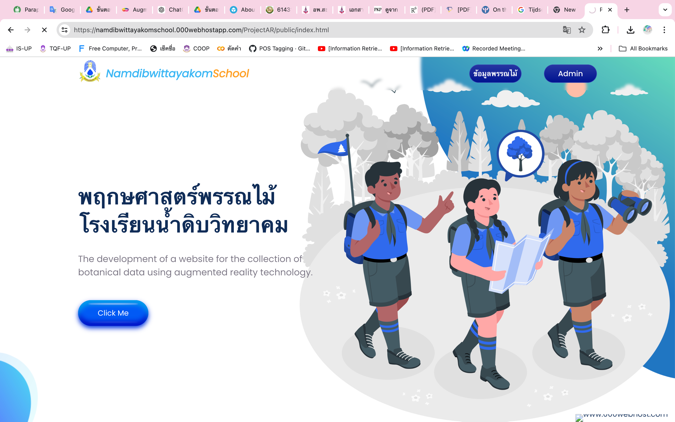Developing a Web Application for Botanical Data Storage Using Augmented Reality Technology: A Case Study of Namdibwittayakom School, Lamphun Province
Keywords:
Augmented reality technology, Plant genetic conservation project under the royal Initiative, Botanical gardenAbstract
Developing a web application for botanical data storage using augmented reality technology, specifically for Namdibwittayakom School in Lamphun Province, was undertaken with the following objectives: 1) to design and develop a web application system for botanical data storage using augmented reality technology, and 2) to study user satisfaction with the web application system for botanical data storage using augmented reality technology. The application was developed to manage data for 62 plant species at Namdibwittayakom School, incorporating augmented reality technology to present learning materials about plants in a more engaging manner. The primary functions of the application include searching for plant information by entering keywords such as plant code, plant name, and properties, as well as retrieving information via QR codes with smartphones to view 3D model representations of the plants. Users can zoom in, zoom out, or rotate the 3D images as needed, accompanied by audio narration in Thai. The system was developed using Visual Studio Code with programming languages including HTML, JavaScript, PHP, and CSS, along with Bootstrap and AngularJS for the system's development. Additionally, XAMPP was used to simulate a computer as a server for system testing, and MySQL was utilized to create a database for storing plant data. For the augmented reality component, 3D tree models were sourced from the Sketchfab platform and integrated with command sets on the MyWebAR platform to enable functionality and display according to the specified commands. User satisfaction evaluation revealed that overall, users expressed a high level of satisfaction with the system, with an average score of 4.55 and a standard deviation of 0.59. When considering individual aspects, the average scores were 4.39 for content, 4.60 for design and layout, and 4.66 for usability, with standard deviations of 0.66, 0.59, and 0.54, respectively.
References
ธิดาภัทร อนุชาญ และ พิษณุ อนุชาญ. (2566). การพัฒนาแอปพลิเคชันด้วยความเป็นจริงเสริมเพื่อส่งเสริมการเรียนรู้สถานที่ท่องเที่ยวเชิงประวัติศาสตร์ตามรอยพระพุทธเจ้าหลวง (รัชกาลที่ ๕) ของจังหวัดสงขลา. วารสารวิชาการพระจอมเกล้าพระนครเหนือ, 33(3), 1-15.
ภัทรณัฐสุดา จารุธีรพันธุ์. (2566). การพัฒนาแอปพลิเคชันความจริงเสริม (AR) สำหรับการนำเสนอผลิตภัณฑ์ชุมชนไทดำ บ้านนาป่าหนาด อำเภอเชียงคาน จังหวัดเลย. วารสารสารสนเทศศาสตร์, 41(1), 87-102.
วรลักษณ์ วงศ์โดยหวัง ศิริเจริญ, ธันยา นวลละออง และ ชุตินันท์ ปทีปะปานี. (2564). เทคนิคความจริงเสริมด้านสุขภาพเพื่อพัฒนาคุณภาพชีวิตผู้สูงอายุ. วารสารวิชาการนวัตกรรมสื่อสารสังคม, 9(1), 120-129.
สำนักงานโครงการอนุรักษ์พันธุกรรมพืชฯ. (2565ก). ตอบรับสมาชิก “สวนพฤกษศาสตร์โรงเรียน”. สืบค้นจาก http://rspg.or.th/botanical_school/neo_sbg/sbg_subscribe_status/north/LPN/751120001_โรงเรียนน้ำดิบวิทยาคม.pdf.
สำนักงานโครงการอนุรักษ์พันธุกรรมพืชฯ. (2565ข). เอกสารเกี่ยวข้องกับงานสวนพฤกษศาสตร์โรงเรียน. สืบค้นจาก http://www.rspg.or.th/botanical_school/scb_document.htm.
อภิวดี จิตเกษมภูรี พิศประไพ สาระศาลิน และชัยพร พานิชรุทติวงศ์. (2562). เทคโนโลยีความจริงเสริมเพื่อการจัดแสดงเครื่องถ้วยไทย. การประชุมวิชาการระดับชาติ มหาวิทยาลัยรังสิต ประจำปี 2562, วันที่ 26 เมษายน 2562 (น. 373-381). ปทุมธานี: สถาบันวิจัย มหาวิทยาลัยรังสิต.
เอกรัฐ วะราโภ และ อรวรรณ แท่งทอง. (2562). สื่อการเรียนรู้ดาวเคราะห์ในระบบสุริยะด้วยเทคโนโลยี Augmented Reality (AR) กรณีศึกษานักเรียน ชั้นประถมศึกษาปีที่ 4. วารสารโครงงานวิทยาการคอมพิวเตอร์และเทคโนโลยีสารสนเทศ, 5(2), 77-83.
Azuma, R.T. (1997). A survey of augmented reality. Presence: Teleoperators and Virtual Environments, 6(4), 355-385.
Best, J.W. (1977). Research in Education (3rd ed). New Jersey: Prentice-Hall, Englewood Cliffs.
Likert, R. (1967). The method of constructing and attitude scale, in attitude theory and measurement. New York: Wiley & Son.
Rovinelli, R.J. and Hambleton, R.K. (1977). On the use of content specialists in the assessment of criterion-referenced test item validity. Tijdschrift voor Onderwijsresearch, 2(2), 49-60.
Yamane, T. (1967). Statistics: An Introductory Analysis (2nd ed). New York: Harper and Row.





